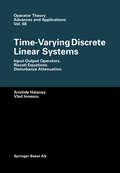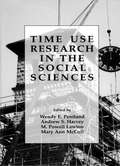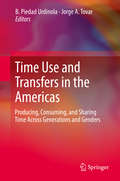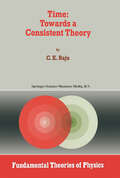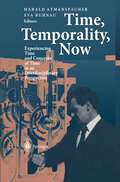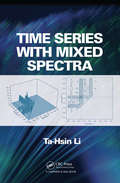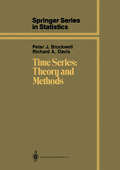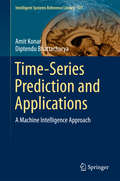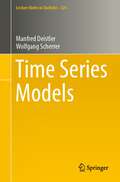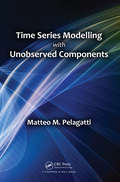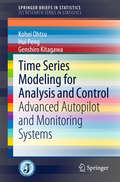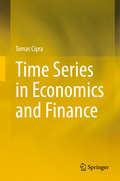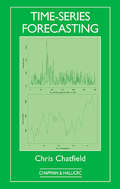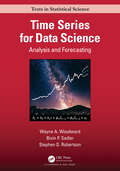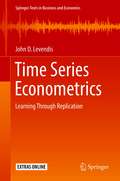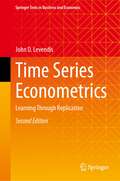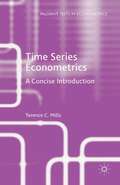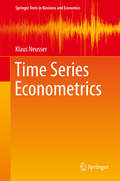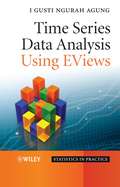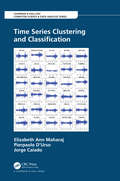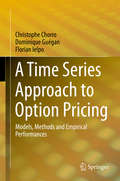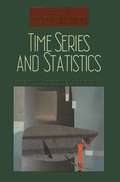- Table View
- List View
Time-Varying Discrete Linear Systems: Input-Output Operators. Riccati Equations. Disturbance Attenuation (Operator Theory: Advances and Applications #68)
by Aristide Halanay Vlad IonescuDiscrete-time systems arise as a matter of course in modelling biological or economic processes. For systems and control theory they are of major importance, particularly in connection with digital control applications. If sampling is performed in order to control periodic processes, almost periodic systems are obtained. This is a strong motivation to investigate the discrete-time systems with time-varying coefficients. This research monograph contains a study of discrete-time nodes, the discrete counterpart of the theory elaborated by Bart, Gohberg and Kaashoek for the continuous case, discrete-time Lyapunov and Riccati equations, discrete-time Hamiltonian systems in connection with input-output operators and associated Hankel and Toeplitz operators. All these tools aim to solve the problems of stabilization and attenuation of disturbances in the framework of H2- and H-control theory. The book is the first of its kind to be devoted to these topics and consists mainly of original, recently obtained results.
Time Use Research in the Social Sciences
by Wendy E. Pentland Andrew S. Harvey M. Powell Lawton Mary Ann McCollThis collection demonstrates the use and variety of applications of time use methodology from multidisciplinary, multinational, and multicultural perspectives. A distinguished roster of contributors from such fields as psychology, occupational therapy, sociology, economics, and architecture examines the complex relationship between human time utilization and health and well-being and evaluates the future of time use analysis as a research tool in the social sciences.
Time Use and Transfers in the Americas: Producing, Consuming, and Sharing Time Across Generations and Genders
by B. Piedad Urdinola Jorge A. TovarThis book provides a comparison of the measurement in time and monetary units of unpaid domestic work in Colombia, Costa Rica, Uruguay, and the Hispanic ethnicity in the United States. A standardized technique allows the development of comparable estimates across countries per age and gender which reveal specific behavioral patterns over the life cycle. A mixture of economic conditions, social norms, and demographic trends provide insightful explanations for the unequal burden that women and girls carry when dealing with unpaid domestic activities, an economically significant but traditionally neglected activity. As such, the book is of interested to practitioners in all social sciences, particularly sociologists, demographers, economists, and policymakers.
Time: Towards a Consistent Theory (Fundamental Theories of Physics #65)
by C.K. RajuIs time, even locally, like the real line? Multiple structures of time, implicit in physics, create a consistency problem. A tilt in the arrow of time is suggested as the most conservative hypothesis which provides approximate consistency within physics and with topology of mundane time. Mathematically, the assumed constancy of the velocity of light (needed to measure time) implies functional differential equations of motion, that have both retarded and advanced deviating arguments with the hypothesis of a tilt. The novel features of such equations lead to a nontrivial structure of time and quantum-mechanical behaviour. The entire argument is embedded in a pedagogical exposition which amplifies, corrects, and questions the conventionally accepted approach. The exposition includes historical details and explains, for instance, why the entropy law is inadequate for time asymmetry, and why notions such as time asymmetry (hence causality) may be conceptually inadequate. The first three parts of the book are especially suited as supplementary reading material for undergraduate and graduate students and teachers of physics. The new ideas are addressed to researchers in physics and philosophy of science concerned with relativity and the interpretation of quantum mechanics.
Time, Temporality, Now: Experiencing Time and Concepts of Time in an Interdisciplinary Perspective
by Harald Atmanspacher Eva RuhnauThe essays in this topical volume inquire into one of the most fundamental issues of philosophy and of the cognitive and natural sciences: the riddle of time. The central feature is the tension between the experience and the conceptualization of time, reflecting an apparently unavoidable antinomy of subjective first-person accounts and objective traditional science. Is time based in the physics of inanimate matter, or does it originate in the operation of our minds? Is it essential for the constitution of reality, or is it just an illusion? Issues of time, temporality, and nowness are paradigms for interdisciplinary work in many contemporary fields of research. The authors of this volume discuss profoundly the mutual relationships and inspiring perspectives. They address a general audience.
Time Series with Mixed Spectra
by Ta-Hsin LiTime series with mixed spectra are characterized by hidden periodic components buried in random noise. Despite strong interest in the statistical and signal processing communities, no book offers a comprehensive and up-to-date treatment of the subject. Filling this void, Time Series with Mixed Spectra focuses on the methods and theory for the stati
Time Series: Theory and Methods (Springer Series in Statistics)
by Peter J. Brockwell Richard A. DavisWe have attempted in this book to give a systematic account of linear time series models and their application to the modelling and prediction of data collected sequentially in time. The aim is to provide specific techniques for handling data and at the same time to provide a thorough understanding of the mathematical basis for the techniques. Both time and frequency domain methods are discussed but the book is written in such a way that either approach could be emphasized. The book is intended to be a text for graduate students in statistics, mathematics, engineering, and the natural or social sciences. It has been used both at the M. S. level, emphasizing the more practical aspects of modelling, and at the Ph. D. level, where the detailed mathematical derivations of the deeper results can be included. Distinctive features of the book are the extensive use of elementary Hilbert space methods and recursive prediction techniques based on innovations, use of the exact Gaussian likelihood and AIC for inference, a thorough treatment of the asymptotic behavior of the maximum likelihood estimators of the coefficients of univariate ARMA models, extensive illustrations of the tech niques by means of numerical examples, and a large number of problems for the reader. The companion diskette contains programs written for the IBM PC, which can be used to apply the methods described in the text.
Time-Series Prediction and Applications: A Machine Intelligence Approach (Intelligent Systems Reference Library #127)
by Amit Konar Diptendu BhattacharyaThis book presents machine learning and type-2 fuzzy sets for the prediction of time-series with a particular focus on business forecasting applications. It also proposes new uncertainty management techniques in an economic time-series using type-2 fuzzy sets for prediction of the time-series at a given time point from its preceding value in fluctuating business environments. It employs machine learning to determine repetitively occurring similar structural patterns in the time-series and uses stochastic automaton to predict the most probabilistic structure at a given partition of the time-series. Such predictions help in determining probabilistic moves in a stock index time-series Primarily written for graduate students and researchers in computer science, the book is equally useful for researchers/professionals in business intelligence and stock index prediction. A background of undergraduate level mathematics is presumed, although not mandatory, for most of the sections. Exercises with tips are provided at the end of each chapter to the readers’ ability and understanding of the topics covered.
Time Series Models (Lecture Notes in Statistics #224)
by Manfred Deistler Wolfgang ScherrerThis textbook provides a self-contained presentation of the theory and models of time series analysis. Putting an emphasis on weakly stationary processes and linear dynamic models, it describes the basic concepts, ideas, methods and results in a mathematically well-founded form and includes numerous examples and exercises. The first part presents the theory of weakly stationary processes in time and frequency domain, including prediction and filtering. The second part deals with multivariate AR, ARMA and state space models, which are the most important model classes for stationary processes, and addresses the structure of AR, ARMA and state space systems, Yule-Walker equations, factorization of rational spectral densities and Kalman filtering. Finally, there is a discussion of Granger causality, linear dynamic factor models and (G)ARCH models. The book provides a solid basis for advanced mathematics students and researchers in fields such as data-driven modeling, forecasting and filtering, which are important in statistics, control engineering, financial mathematics, econometrics and signal processing, among other subjects.
Time Series Modelling with Unobserved Components
by Matteo M. PelagattiDespite the unobserved components model (UCM) having many advantages over more popular forecasting techniques based on regression analysis, exponential smoothing, and ARIMA, the UCM is not well known among practitioners outside the academic community. Time Series Modelling with Unobserved Components rectifies this deficiency by giving a practical o
Time Series Modeling for Analysis and Control: Advanced Autopilot and Monitoring Systems (SpringerBriefs in Statistics)
by Kohei Ohtsu Hui Peng Genshiro KitagawaThis book presents multivariate time series methods for the analysis and optimal control of feedback systems. Although ships’ autopilot systems are considered through the entire book, the methods set forth in this book can be applied to many other complicated, large, or noisy feedback control systems for which it is difficult to derive a model of the entire system based on theory in that subject area. The basic models used in this method are the multivariate autoregressive model with exogenous variables (ARX) model and the radial bases function net-type coefficients ARX model. The noise contribution analysis can then be performed through the estimated autoregressive (AR) model and various types of autopilot systems can be designed through the state–space representation of the models. The marine autopilot systems addressed in this book include optimal controllers for course-keeping motion, rolling reduction controllers with rudder motion, engine governor controllers, noise adaptive autopilots, route-tracking controllers by direct steering, and the reference course-setting approach. The methods presented here are exemplified with real data analysis and experiments on real ships. This book is highly recommended to readers who are interested in designing optimal or adaptive controllers not only of ships but also of any other complicated systems under noisy disturbance conditions.
Time Series in Economics and Finance
by Tomas CipraThis book presents the principles and methods for the practical analysis and prediction of economic and financial time series. It covers decomposition methods, autocorrelation methods for univariate time series, volatility and duration modeling for financial time series, and multivariate time series methods, such as cointegration and recursive state space modeling. It also includes numerous practical examples to demonstrate the theory using real-world data, as well as exercises at the end of each chapter to aid understanding. This book serves as a reference text for researchers, students and practitioners interested in time series, and can also be used for university courses on econometrics or computational finance.
Time-Series Forecasting
by Chris ChatfieldFrom the author of the bestselling "Analysis of Time Series," Time-Series Forecasting offers a comprehensive, up-to-date review of forecasting methods. It provides a summary of time-series modelling procedures, followed by a brief catalogue of many different time-series forecasting methods, ranging from ad-hoc methods through ARIMA and state-space
Time Series for Data Science: Analysis and Forecasting (Chapman & Hall/CRC Texts in Statistical Science)
by Wayne A. Woodward Bivin Philip Sadler Stephen RobertsonData Science students and practitioners want to find a forecast that “works” and don’t want to be constrained to a single forecasting strategy, Time Series for Data Science: Analysis and Forecasting discusses techniques of ensemble modelling for combining information from several strategies. Covering time series regression models, exponential smoothing, Holt-Winters forecasting, and Neural Networks. It places a particular emphasis on classical ARMA and ARIMA models that is often lacking from other textbooks on the subject.This book is an accessible guide that doesn’t require a background in calculus to be engaging but does not shy away from deeper explanations of the techniques discussed.Features: Provides a thorough coverage and comparison of a wide array of time series models and methods: Exponential Smoothing, Holt Winters, ARMA and ARIMA, deep learning models including RNNs, LSTMs, GRUs, and ensemble models composed of combinations of these models. Introduces the factor table representation of ARMA and ARIMA models. This representation is not available in any other book at this level and is extremely useful in both practice and pedagogy. Uses real world examples that can be readily found via web links from sources such as the US Bureau of Statistics, Department of Transportation and the World Bank. There is an accompanying R package that is easy to use and requires little or no previous R experience. The package implements the wide variety of models and methods presented in the book and has tremendous pedagogical use.
Time Series for Data Science: Analysis and Forecasting (Chapman & Hall/CRC Texts in Statistical Science)
by Wayne A. Woodward Bivin Philip Sadler Stephen RobertsonData Science students and practitioners want to find a forecast that “works” and don’t want to be constrained to a single forecasting strategy, Time Series for Data Science: Analysis and Forecasting discusses techniques of ensemble modelling for combining information from several strategies. Covering time series regression models, exponential smoothing, Holt-Winters forecasting, and Neural Networks. It places a particular emphasis on classical ARMA and ARIMA models that is often lacking from other textbooks on the subject.This book is an accessible guide that doesn’t require a background in calculus to be engaging but does not shy away from deeper explanations of the techniques discussed.Features: Provides a thorough coverage and comparison of a wide array of time series models and methods: Exponential Smoothing, Holt Winters, ARMA and ARIMA, deep learning models including RNNs, LSTMs, GRUs, and ensemble models composed of combinations of these models. Introduces the factor table representation of ARMA and ARIMA models. This representation is not available in any other book at this level and is extremely useful in both practice and pedagogy. Uses real world examples that can be readily found via web links from sources such as the US Bureau of Statistics, Department of Transportation and the World Bank. There is an accompanying R package that is easy to use and requires little or no previous R experience. The package implements the wide variety of models and methods presented in the book and has tremendous pedagogical use.
Time Series Econometrics: Learning Through Replication (Springer Texts in Business and Economics)
by John D. LevendisIn this book, the author rejects the theorem-proof approach as much as possible, and emphasize the practical application of econometrics. They show with examples how to calculate and interpret the numerical results. This book begins with students estimating simple univariate models, in a step by step fashion, using the popular Stata software system. Students then test for stationarity, while replicating the actual results from hugely influential papers such as those by Granger and Newbold, and Nelson and Plosser. Readers will learn about structural breaks by replicating papers by Perron, and Zivot and Andrews. They then turn to models of conditional volatility, replicating papers by Bollerslev. Finally, students estimate multi-equation models such as vector autoregressions and vector error-correction mechanisms, replicating the results in influential papers by Sims and Granger. The book contains many worked-out examples, and many data-driven exercises. While intended primarily for graduate students and advanced undergraduates, practitioners will also find the book useful.
Time Series Econometrics: Learning Through Replication (Springer Texts in Business and Economics)
by John D. LevendisRevised and updated for the second edition, this textbook allows students to work through classic texts in economics and finance, using the original data and replicating their results. In this book, the author rejects the theorem-proof approach as much as possible, and emphasizes the practical application of econometrics. They show with examples how to calculate and interpret the numerical results.This book begins with students estimating simple univariate models, in a step by step fashion, using the popular Stata software system. Students then test for stationarity, while replicating the actual results from hugely influential papers such as those by Granger & Newbold, and Nelson & Plosser. Readers will learn about structural breaks by replicating papers by Perron, and Zivot & Andrews. They then turn to models of conditional volatility, replicating papers by Bollerslev. Students estimate multi-equation models such as vector autoregressions and vector error-correction mechanisms, replicating the results in influential papers by Sims and Granger. Finally, students estimate static and dynamic panel data models, replicating papers by Thompson, and Arellano & Bond.The book contains many worked-out examples, and many data-driven exercises. While intended primarily for graduate students and advanced undergraduates, practitioners will also find the book useful.“How to best start learning time series econometrics? Learning by doing. This is the ethos of this book. What makes this book useful is that it provides numerous worked out examples along with basic concepts. It is a fresh, no-nonsense, practical approach that students will love when they start learning time series econometrics. I recommend this book strongly as a study guide for students who look for hands-on learning experience."--Professor Sokbae "Simon" Lee, Columbia University, Co-Editor of Econometric Theory and Associate Editor of Econometrics Journal.
Time Series Econometrics: A Concise Introduction (Palgrave Texts in Econometrics)
by Terence C. MillsThis book provides an introductory treatment of time series econometrics, a subject that is of key importance to both students and practitioners of economics. It contains material that any serious student of economics and finance should be acquainted with if they are seeking to gain an understanding of a real functioning economy.
Time Series Econometrics (Springer Texts in Business and Economics)
by Klaus NeusserThis text presents modern developments in time series analysis and focuses on their application to economic problems. The book first introduces the fundamental concept of a stationary time series and the basic properties of covariance, investigating the structure and estimation of autoregressive-moving average (ARMA) models and their relations to the covariance structure. The book then moves on to non-stationary time series, highlighting its consequences for modeling and forecasting and presenting standard statistical tests and regressions. Next, the text discusses volatility models and their applications in the analysis of financial market data, focusing on generalized autoregressive conditional heteroskedastic (GARCH) models. The second part of the text devoted to multivariate processes, such as vector autoregressive (VAR) models and structural vector autoregressive (SVAR) models, which have become the main tools in empirical macroeconomics. The text concludes with a discussion of co-integrated models and the Kalman Filter, which is being used with increasing frequency. Mathematically rigorous, yet application-oriented, this self-contained text will help students develop a deeper understanding of theory and better command of the models that are vital to the field. Assuming a basic knowledge of statistics and/or econometrics, this text is best suited for advanced undergraduate and beginning graduate students.
Time Series Data Analysis Using EViews: Forecasting Using Eviews
by I. Gusti AgungDo you want to recognize the most suitable models for analysis of statistical data sets? This book provides a hands-on practical guide to using the most suitable models for analysis of statistical data sets using EViews - an interactive Windows-based computer software program for sophisticated data analysis, regression, and forecasting - to define and test statistical hypotheses. Rich in examples and with an emphasis on how to develop acceptable statistical models, Time Series Data Analysis Using EViews is a perfect complement to theoretical books presenting statistical or econometric models for time series data. The procedures introduced are easily extendible to cross-section data sets. The author: Provides step-by-step directions on how to apply EViews software to time series data analysis Offers guidance on how to develop and evaluate alternative empirical models, permitting the most appropriate to be selected without the need for computational formulae Examines a variety of times series models, including continuous growth, discontinuous growth, seemingly causal, regression, ARCH, and GARCH as well as a general form of nonlinear time series and nonparametric models Gives over 250 illustrative examples and notes based on the author's own empirical findings, allowing the advantages and limitations of each model to be understood Describes the theory behind the models in comprehensive appendices Provides supplementary information and data sets An essential tool for advanced undergraduate and graduate students taking finance or econometrics courses. Statistics, life sciences, and social science students, as well as applied researchers, will also find this book an invaluable resource.
Time Series Data Analysis Using EViews
by I. Gusti AgungDo you want to recognize the most suitable models for analysis of statistical data sets? This book provides a hands-on practical guide to using the most suitable models for analysis of statistical data sets using EViews - an interactive Windows-based computer software program for sophisticated data analysis, regression, and forecasting - to define and test statistical hypotheses. Rich in examples and with an emphasis on how to develop acceptable statistical models, Time Series Data Analysis Using EViews is a perfect complement to theoretical books presenting statistical or econometric models for time series data. The procedures introduced are easily extendible to cross-section data sets. The author: Provides step-by-step directions on how to apply EViews software to time series data analysis Offers guidance on how to develop and evaluate alternative empirical models, permitting the most appropriate to be selected without the need for computational formulae Examines a variety of times series models, including continuous growth, discontinuous growth, seemingly causal, regression, ARCH, and GARCH as well as a general form of nonlinear time series and nonparametric models Gives over 250 illustrative examples and notes based on the author's own empirical findings, allowing the advantages and limitations of each model to be understood Describes the theory behind the models in comprehensive appendices Provides supplementary information and data sets An essential tool for advanced undergraduate and graduate students taking finance or econometrics courses. Statistics, life sciences, and social science students, as well as applied researchers, will also find this book an invaluable resource.
Time Series Clustering and Classification (Chapman & Hall/CRC Computer Science & Data Analysis)
by Elizabeth Ann Maharaj Pierpaolo D'Urso Jorge CaiadoThe beginning of the age of artificial intelligence and machine learning has created new challenges and opportunities for data analysts, statisticians, mathematicians, econometricians, computer scientists and many others. At the root of these techniques are algorithms and methods for clustering and classifying different types of large datasets, including time series data. Time Series Clustering and Classification includes relevant developments on observation-based, feature-based and model-based traditional and fuzzy clustering methods, feature-based and model-based classification methods, and machine learning methods. It presents a broad and self-contained overview of techniques for both researchers and students. Features Provides an overview of the methods and applications of pattern recognition of time series Covers a wide range of techniques, including unsupervised and supervised approaches Includes a range of real examples from medicine, finance, environmental science, and more R and MATLAB code, and relevant data sets are available on a supplementary website
Time Series Clustering and Classification (Chapman & Hall/CRC Computer Science & Data Analysis)
by Elizabeth Ann Maharaj Pierpaolo D'Urso Jorge CaiadoThe beginning of the age of artificial intelligence and machine learning has created new challenges and opportunities for data analysts, statisticians, mathematicians, econometricians, computer scientists and many others. At the root of these techniques are algorithms and methods for clustering and classifying different types of large datasets, including time series data. Time Series Clustering and Classification includes relevant developments on observation-based, feature-based and model-based traditional and fuzzy clustering methods, feature-based and model-based classification methods, and machine learning methods. It presents a broad and self-contained overview of techniques for both researchers and students. Features Provides an overview of the methods and applications of pattern recognition of time series Covers a wide range of techniques, including unsupervised and supervised approaches Includes a range of real examples from medicine, finance, environmental science, and more R and MATLAB code, and relevant data sets are available on a supplementary website
A Time Series Approach to Option Pricing: Models, Methods and Empirical Performances
by Christophe Chorro Dominique Guégan Florian IelpoThe current world financial scene indicates at an intertwined and interdependent relationship between financial market activity and economic health. This book explains how the economic messages delivered by the dynamic evolution of financial asset returns are strongly related to option prices. The Black Scholes framework is introduced and by underlining its shortcomings, an alternative approach is presented that has emerged over the past ten years of academic research, an approach that is much more grounded on a realistic statistical analysis of data rather than on ad hoc tractable continuous time option pricing models. The reader then learns what it takes to understand and implement these option pricing models based on time series analysis in a self-contained way. The discussion covers modeling choices available to the quantitative analyst, as well as the tools to decide upon a particular model based on the historical datasets of financial returns. The reader is then guided into numerical deduction of option prices from these models and illustrations with real examples are used to reflect the accuracy of the approach using datasets of options on equity indices.
Time Series and Statistics (The New Palgrave)
by John Eatwell Murray Milgate Peter NewmanThis is an excerpt from the 4-volume dictionary of economics, a reference book which aims to define the subject of economics today. 1300 subject entries in the complete work cover the broad themes of economic theory. This extract concentrates on time series and statistics.
